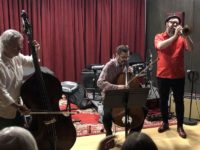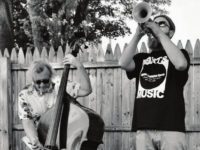The history of jazz is a history of personalities; from the affable Satchmo, the showmanship of Diz, the gentlemanly ways of Ellington, to the intensely insular Miles. It seemed in most of these cases, the music reflected their personalities, too.
You can’t have a discussion about characters in jazz with including Rahsaan Roland Kirk, however.
Kirk stood out as an odd sort in a long parade of jazz eccentrics. His brash, loud unpredictable demeanor was vividly reflected in his music. When he played straight jazz, you never knew if he was going to stop on a dime and switch over to r&b, rock-n-roll, whack jazz or something downright schmaltzy. What’s more, you didn’t know if he was being ironic or not. It didn’t really matter, though, because whatever he tackled was done at the highest level of musicianship.
Rahsaan Roland Kirk, of course, is best known as that crazy blind guy who could not only play just about every wind instrument ever invented, from manzello to nose flute, he could play up to four or five of them simultaneously. When he chose to play an instrument exclusively, it was as good as it gets for that instrument. Just ask Ian Anderson of Jethro Tull who his primary influence is on flute.
Through all the zaniness, though, Kirk had a deep reverence to the greats who came before him and, like his one-time boss Charles Mingus, used tradition as a springboard to expand jazz’s boundaries. No more is that in evidence than on his 1965 masterpiece Rip, Rig and; Panic.
Besides sporting what has to be the hippest title ever attached to an album, Rip was a rare time Kirk enjoyed a top shelf rhythm section: Jaki Byard on piano, Richard Davis on bass and the big, bad Elvin Jones on drums. Engineered by that legend Rudy Van Gelder at his studios along with Kirk being at the peak of his considerable powers, this is the finest of Kirk albums, with the possible exception of The Inflated Tear.
Even paired up with the 1967 follow-up Now Please Don’t You Cry Beautiful Edith on a single CD, the whole collection takes listeners on a carnival ride of the familiar jarringly mashed up against the unexpected.
The right thing to do would be to cover the entire album, but since there are simply too many incredible things happening on it to write in a neat-and-tidy review size, I’ll pick one song that illustrates the genius at work.
“Rip, Rig and Panic,” the song, is Rahsaan Roland Kirk waking up his audience from the comfort of conventional jazz. His tenor along with Davis’ bass commence with a dissonant sound that gets more menacing until abruptly broken up by the sound of shattering glass. It’s here when the theatrical, Mingus-styled theme is introduced before Kirk, Byard and Jones go off into solos.
Rahsaan starts off with a tenor alone that rains down notes sometimes with hailstorm intensity, punctuated by a few duck honks and then he adds another horn (manzello, perhaps?) before making way for his piano player. Byard, who was probably the closest thing to being Kirk on the piano, plays fractured lines that come right out the Thelonius Monk school of thought with some Bud Powell and a little Cecil Taylor seeping in.
When it comes time for Jones to perform his drum solo, he pulls no punches. In a career full of memorable moments behind the kit, his 50-second thunderous display of percussion on this cut is up there among his best on record. As well as ‘Trane’s drummer was playing on the entire album, he seemed ready to uncork a pearl like this at any moment. As if to say that Elvin’s playing was so smokin’ hot, Rahsaan Roland Kirk can be heard toward the end of it sounding off a fire engine siren.
After a final statement of that theme the songs ends in a tumultuous clang, and as Kirk is shouting out the song title, he’s nearly drowned out by this weird, static-y noise that Kirk said was created by shaking around an amplifier. It’s one of a handful of spots on the album where Kirk added in some electronic effects. Over the last few years, we’ve seen an explosion of “electro/acoustic” jazz combining performed, organic music with odd, plugged-in sounds. Here we have Rahsaan Roland Kirk doing it more than 40 years ago.
For a guy who couldn’t see, ol’ Rah sure had a lot of vision.





Great Review! This is my favorite Kirk album and one of my favorite Jazz albums in general. I once read that when Jimi Hendrix first stepped off a plane in London, this was one of the few records he brought with him.
The LP came out on Limelight which seems to have been Mercury Records’ last foray into legitimate jazz. I have a 70s repress with the pink and green label. The music sounds spectacular but the vinyl surface is uneven leading to background noise in between songs and at the quietest parts of the music.
Hopefully, I can snag an original green and black label pressing someday…
I first met Roland before he became Rahsaan at the Musicians Union Local #47 in Hollywood — a nice, laid back cat, carried all of his horns in a golf bag, even his stritch horn. This was in the early 1960s.
P.S.: He beat me in a game of 8 ball.
Pingback: Remembering Duane Allman's Brushes with the Jazz World